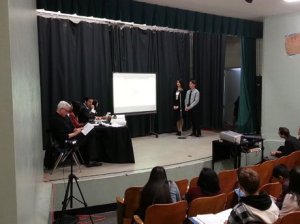Business Students Dive into the “Shark Tank”
"School is boring." There is no place for that statement when teachers are creative, engaging and promote genuine learning. But how do teachers make their classes the opposite of boring?
When I began teaching high school business courses four years ago, I was just 23 years old. Because I had recently lived through traditional high school and college instruction, I knew there had to be a different way -- a better way.
Inspiration struck one night, months into my first year of teaching, while watching what was then a new TV show called Shark Tank. Here, entrepreneurs pitch their business ideas to millionaire and billionaire investors in the hope of securing funding to start, grow or save their business. When I showed my business students one episode, they begged to watch more. At that point, I knew I had something. So, to capitalize on my students' enthusiasm, I created a project out of it.
Entrepreneurs in Training
In my Business 100 class, students begin the Shark Tank project by assuming the role of an entrepreneur tasked with devising a proprietary, practical invention that can be a product or service. They spend months developing a business plan for their invention while, along the way, learning important business concepts from the course outline. Skills align with the Common Core State Standards, specifically critical thinking and problem solving.
In developing their inventions, students learn about the importance of legally protecting their company via a patent, and protecting their logo and tagline with a trademark. They learn the costs associated with leasing a space to conduct business operations. Additionally, they use those Common Core staples of critical thinking and problem solving to determine their cost of goods sold, distribution methods, marketing tactics and total start-up funds that would be required to launch their businesses. Skills learned in English class are reinforced, in that each Shark Tank assignment is accepted only if there are no spelling, grammar or punctuation errors.
At the project's completion, students create a prototype and pitch their invention to real business owners, just like on the show. This year's business invention ideas include voice-activated and -controlled headphones, a retractable and expandable travel bag, and a stylish hat line with changeable brims -- just to name a few!
Feedback from the Sharks
"One of the hardest parts of the Shark Tank project was finding out how much it would cost to make my product," said sophomore Alex Fields. "I had to first figure out if it was important to me to make it in the U.S., rather than overseas. Then I had to figure out where to find my parts at the lowest price, while making sure they were going to still be good quality."
Over the years, students have presented to many different "sharks" (investors) including the president of a software design company, the CEO of a marketing company, and the president and founder of a manufacturing company, along with multiple local business owners who represent a variety of industry sectors. Besides commending the students on their presentation skills and creativity, sharks point out areas of improvement, mostly centering on marketing strategies and the accuracy of data that students have researched for their pitch.
While no money is actually awarded from any of the investors, students acquire important business knowledge and skills throughout the process. "I know I'm young, but I've always wanted to start my own business," said sophomore Alexandria Lennen. "I still do, but I'm now way more prepared after completing the Shark Tank project. It was so awesome!"
Said sophomore Harmony Ordaz, "The Shark Tank project has opened my eyes to how much work it really takes to be an entrepreneur. Starting your own business is definitely not for everyone. It's been so much fun to learn all this by doing it, not just listening or watching something about it."

The Opposite of Boring
With the project now in its fourth year, the student body at my school has developed an excitement for the event. Last year, over 500 students and staff members attended the presentations. It is exciting for me that enthusiasm for an in-school project has expanded to a large audience outside of the classroom.
Like I said earlier, school should never be boring. My relative youth has been an advantage for engaging my students, because I am up on their media obsessions, social networking habits, fashion trends, and have a sense of what might be an interesting project. I try to put myself in students' shoes and match assignments to their interests.
So ask yourself, "How am I getting my students to be excited about learning?" Maybe it's time to let them (safely) swim with sharks.
